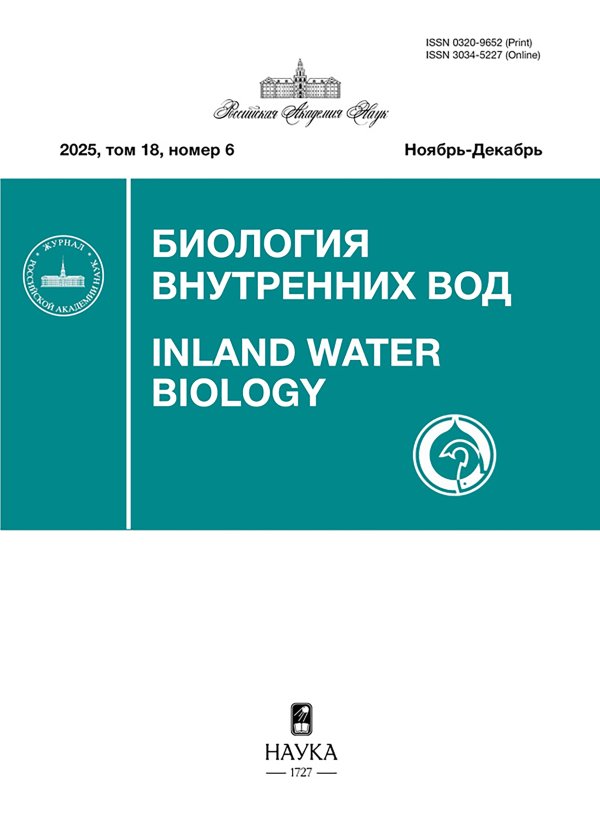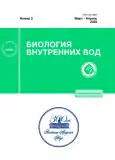Is Aquatic Fern Salvinia natans (Salviniaceae) Rare in Russia?
- Authors: Konotop N.K.1,2, Vinogradova Y.S.1,2, Chemeris E.V.1, Bobrov A.A.1,3
-
Affiliations:
- Papanin Institute for Biology of Inland Waters Russian Academy of Sciences
- Yaroslavl State University
- Tyumen State University, AquaBioSafe
- Issue: No 2 (2023)
- Pages: 134-145
- Section: ВОДНАЯ ФЛОРА И ФАУНА
- URL: https://journals.rcsi.science/0320-9652/article/view/134936
- DOI: https://doi.org/10.31857/S0320965223020146
- EDN: https://elibrary.ru/BTMQUW
- ID: 134936
Cite item
Full Text
Abstract
According to publication and literature, herbarium data, materials of Internet resources, the change in distribution of aquatic fern Salvinia natans (Salviniaceae) on Russian territory was traced since the beginning of XX century until 2021, and the current boundaries of its range were determined. Among the bioclimatic and temperature indicators that determine the distribution of S. natans, the minimum and maximum temperatures in October and January and the maximum temperatures in April and July showed the highest statistical significance, which is associated with important stages of the life cycle of S. natans. Comparison of species localities with climatic and temperature indicators for the time periods of 1960–1969, 2010–2018, 2011–2021 showed that up to 2021 in the European part, West Siberia, and the Far East there was significant spreading of S. natans to the north (more than 200 km). A notable increase in the number of records of the species has been found since the 2000s in different regions. For example, in the Ivanovo Region from 2018 to 2021 their number has increased more than three time. The expansion of the species occurs against the background of a noticeable increase in average annual temperatures and changes in other bioclimatic indicators. If present temperature trends continue, S. natans will expand its range even further north, east, and west in European Russia, north and west in West Siberia and the Far East. Due to the ongoing expansion of S. natans, the premises for the exclusion of the species from a number of regional Red Data Books were discussed.
About the authors
N. K. Konotop
Papanin Institute for Biology of Inland Waters Russian Academy of Sciences; Yaroslavl State University
Email: lechem@ibiw.ru
Russia, Nekouzskii raion, Yaroslavl oblast, Borok; Russia, Yaroslavl
Yu. S. Vinogradova
Papanin Institute for Biology of Inland Waters Russian Academy of Sciences; Yaroslavl State University
Email: lechem@ibiw.ru
Russia, Nekouzskii raion, Yaroslavl oblast, Borok; Russia, Yaroslavl
E. V. Chemeris
Papanin Institute for Biology of Inland Waters Russian Academy of Sciences
Author for correspondence.
Email: lechem@ibiw.ru
Russia, Nekouzskii raion, Yaroslavl oblast, Borok
A. A. Bobrov
Papanin Institute for Biology of Inland Waters Russian Academy of Sciences; Tyumen State University, AquaBioSafe
Email: lechem@ibiw.ru
Russia, Nekouzskii raion, Yaroslavl oblast, Borok; Russia, Tyumen
References
- Агафонов В.А., Стародубцева Е.А., Негробов В.В. и др. 2019. Кадастр сосудистых растений, охраняемых на территории Воронежской области. Воронеж: Цифровая полиграфия. С. 370.
- Барабанщикова Н.С., Орлюк Ф.А. 2021. Влияние экспериментальных условий хранения спор сальвинии плавающей (Salvinia natans (L.) All., Salviniaceae Martinov) на воспроизводство вида // Проблемы ботаники Южной Сибири и Монголии. Т. 20. № 1. С. 49. https://doi.org/10.14258/pbssm.2021010
- Бобров А.Е., Бобров Е.Г., Федоров А.А., Цвелев Н.Н. 1974. Флора Европейской части СССР. Т. 1. Ленинград: Изд-во “Наука”. С. 1.
- Губанов И.А., Киселева К.В., Новиков В.С., Тихомиров В.Н. 2002. Иллюстрированный определитель растений Средней России. Т. 1. Москва: Товарищество научн. изданий КМК. С. 100.
- Ефремов А.Н., Свириденко Б.Ф., Свириденко Т.В., Мурашко Ю.А. 2018. Сальвиния плавающая Salvinia natans (L.) All. в Омской области // Экология и география растений и растительных сообществ: Матер. IV междунар. науч. конф. (Екатеринбург, 16–19 апреля 2018 г.). Екатеринбург: Изд-во Уральск. ун-та; Гуманитарный ин-т. С. 270.
- Кособокова С.Р., Барабанщикова Н.С. 2015. Особенности размножения сальвинии плавающей Salvinia natans // Естественные науки. № 2(51). С. 36.
- Красная книга Алтайского края. Т. 1. 2016. Барнаул: Изд-во Алтайск. ун-та.
- Красная книга Новосибирской области: Животные, растения и грибы. 2018. Новосибирск: Типография А. Христолюбова.
- Кулуев Б.Р., Артюхин А.Е., Михайлова Е.В. 2017. Новые находки Salvinia natans (L.) All. в Нуримановском районе Республики Башкортостан // Биомика. Т. 9. № 2. С. 136.
- Леострин А.В., Ефимова А.А. 2020. Материалы для флоры Костромской обл. // Turczaninowia. Т. 23. № 2. С. 99.
- Орлов Ю.А. 1963. Основы палеонтологии. Т. 14. Водоросли, мохообразные, псилофитовые, плауновидные, членистостебельные, папоротники. Москва: Изд-во АН СССР.
- Папченков В.Г. 2000. Динамика гидроботанических исследований в России // Гидроботаника-2000. Тез. докл. V Всерос. конф. по водным растениям. Борок. С. 218.
- Сорокин А.И., Голубева М.А. 2020. О находке Salvinia natans (L.) All. в Ивановской и Костромской областях // Проблемы ботаники: история и современность: Матер. межд. науч. конф. (Воронеж, 3–7 февраля 2020 г.). Воронеж: Воронеж. гос. ун-т. С. 346.
- Степанов Н.В. 2003. Высшие споровые растения: учебное пособие. Красноярск: Красноярск. гос. ун-т.
- Филатов Н.Н., Руховец Л.А., Назарова Л.Е. и др. 2014. Влияние изменений климата на экосистемы озер севера Европейской территории России // Уч. зап. Росс. гос. гидромет. ун-та. № 34. С. 48.
- Шевченко А.М., Артюхин А.Е. 2016. К распространению сальвинии плавающей Salvinia natans (L.) All. в Республике Башкортостан // Мат. по флоре и фауне Респ. Башкортостан. № 13. С. 121.
- Allen D.J. 2011. Salvinia natans. The IUCN Red List of Threatened Species 2011: e.T163996A5688211. [Электронный ресурс] URL: https://www.iucnredlist.org/species/163996/5688211 (Дата обращения: 15.03.2022).
- Bezsmertna O.O., Heluta V.P., Danylyk I.M. et al. 2020. Distribution of Salvinia natans (Salviniaceae, Polypodiopsida), a fern listed in the Red Data Book of Ukraine, within the country // Ukrainian Botanical Journal. V. 77. № 3. P. 173. https://doi.org/10.15407/ukrbotj77.03.173
- Christenhusz M., Lansdown R.V., Bento E.R. et al. 2017. Salvinia natans. The IUCN Red List of Threatened Species 2017: e.T163996A85449648. [Электронный ресурс]. https://www.iucnredlist.org/species/163996/ 85449648 (Accessed on 12.04.2022).
- Fick S.E., Hijmans R.J. 2017. WorldClim 2: new 1 km spatial resolution climate surfaces for global land areas // Int. J. Climatology. V. 37. № 12. P. 4302. [Электронный ресурс] URL: https://www.worldclim.org/data/ worldclim21.html (Accessed on 20.02.2022).
- Filatov N., Baklagin V., Efremova T. et al. 2019. Climate change impacts on the watersheds of Lakes Onego and Ladoga from remote sensing and in situ data // Inland Waters Biol. V. 9. № 2. P. 130. https://doi.org/10.1080/20442041.2018.1533355
- Gałka A., Szmeja J. 2012. Distribution, abundance and environmental conditions of the clonal aquatic fern Salvinia natans (L.) All. in the Vistula delta (Baltic Sea Region) // Biodiversity Research and Conservation. V. 28. P. 45. https://doi.org/10.2478/v10119-012-0020-7
- Gałka A., Szmeja J. 2013. Phenology of the aquatic fern Salvinia natans (L.) All. in the Vistula Delta in the context of climate warming // Limnol. V. 43. P. 100. https://doi.org/10.1016/j.limno.2012.07.001
- Gillard M.B., Aroviita J., Alahuhta J. 2020. Same species, same habitat preferences? The distribution of aquatic plants is not explained by the same predictors in lakes and streams // Freshwater Biol. V. 1. P. 11. https://doi.org/10.1111/fwb.1347
- Kłosowski S., Pawlikowski P., Jabłońska E., Podgórska M. 2020. Habitat conditions of the Salvinia natans phytocoenoses in the Vistula and Odra river valleys in Poland // Tuexenia. V. 40. P. 327. https://doi.org/10.14471/2020.40.002
- Kotsun L., Radzii V., Kotsun B. 2021. Spread monitoring of Salvinia natans (L.) All. in the Turia river within the city Kovel // Notes Curr. Biol. V. 1. № 2. P. 8. https://doi.org/10.29038/NCBio.21.2.8-14
- Mucina L., Bülmann H., Dierßen K., Tichý L. 2016. Vegetation of Europe. Hierarchical floristic classification system of vascular plant, bryophyte, lichen and algal communities // Appl. Veg. Sci. V. 19. P. 3. https://doi.org/10.1111/avsc.12257
- Pietryka M., Richter D., Podlaska M. 2018. The distribution of Salvinia natans (L.) All. in the Odra and the Oława River valleys in Wrocław area (Poland) // Biodiv. Res. Conserv. V. 49. № 1. P. 7. https://doi.org/10.2478/biorc-2018-0002
- Szmeja J., Gałka-Kozak A., Styszyńska A., Marsz A. 2016. Early spring warming as one of the factors responsible for expansion of aquatic fern Salvinia natans (L.) All. in the Vistula delta (south Baltic Sea coast) // Plant Biosystems. V. 150. № 3. P. 532. https://doi.org/10.1080/11263504.2014.987189
- Wang J., Zheng Y., Wang G. 2013. Is Salvinia natans (L.) All. a Water Quality Improver? // Asian Journal of Chemistry. V. 25. № 11. P. 6159. https://doi.org/10.14233/ajchem.2013.14297
- Wang T., Dou H., Liu C., Yu D. 2021. Decoupling between plant growth and functional traits of the free-floating fern Salvinia natans under shifted water nutrient stoichiometric regimes // Flora. V. 281. https://doi.org/10.1016/j.flora.2021.151876
Supplementary files


















